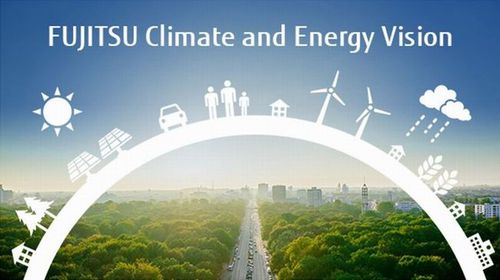September 22, 2017
Fujitsu Establishes Medium- to Long-Term Environmental Vision Through 2050
Keywords: Climate Change Corporate

Copyright 2017 Fujitsu All Rights Reserved.
The Fujitsu Group released the FUJITSU Climate and Energy Vision, a medium- to long-term environmental vision through 2050, on May 12, 2017. This article introduces the Group's vision to realize zero carbon dioxide (CO2) emissions and contribute to the goal of achieving a decarbonized society.
The Fujitsu Group, a major Japanese manufacturer of communications and information processing systems, has established the FUJITSU Climate and Energy Vision, a medium- to long-term environmental vision of the Group through 2050. This vision clarifies the roles that the Group should play in addressing climate change, as well as the future vision that it should realize as a global information and communication technology (ICT) business.
The factors behind the establishment of the vision include the Paris Agreement that became effective in November 2016. The Agreement specifies the goal of limiting the increase in average temperature below two degrees Celsius when compared with preindustrial levels as an international framework to address global warming after 2020. To achieve this, a significant shift from "low carbon" to "decarbonization" is necessary.
In the global market, it is predicted that restrictions on CO2 emissions will be tightened, carbon prices will soar, and a carbon tax will be introduced. In addition, withdrawal from investment in the fossil fuel industry has proceeded, while environmental, social and governance (ESG) investment has increased. A change in market rules is also noticeable.
This vision aims to take measures to achieve the Group's decarbonization as early as possible, through the use of ICT. In addition, it also aims to provide customers and society with its expertise and digital technologies as a solution, in an attempt to contribute to the mitigation and adaptation of climate change through its business. The vision is composed of the following three axes:
The first is to bring its own CO2 emissions down to zero. To achieve this, the Group will develop and deploy up-to-date technologies, such as optimizing the power consumption of data centers through artificial intelligence (AI) control. The Group will also strategically employ renewable energy sources and carbon credits, to achieve the goal for itself of zero CO2 emissions. .
The second is to contribute to achieving a decarbonized society. The Group will work with customers in a variety of industries and business categories, such as smart mobility and smart manufacturing, to shape their ecosystems. For instance, the Group will analyze and predict information on positional data, weather information, and traffic volume in real time to optimize automotive transportation. By digitally connecting a variety of products and services, the Group will also help optimize the use of energy across entire social systems.
The third is to adapt to climate change. The Group will help mitigate the damage from climate change on customers and society by using sensing technology, simulations based on high-performance computing (HPC), and advanced predictions of supply and demand using AI. For example, the Group will use technologies that support digital innovation for solutions, such as building resilient social infrastructure, enabling a stable supply of agricultural products, and minimizing food loss across the supply chain.
By achieving this vision, Fujitsu Group will create innovation using ICT, in an effort to play a leading role in realizing a decarbonized society.
Related
"JFS Newsletter"
- 'Good Companies in Japan' (Article No.4): 'Eightfold Satisfaction' Management for Everyone's Happiness
- 'Good Companies in Japan' (Article No.3): Seeking Ways to Develop Societal Contribution along with Core Businesses
- "Good Companies in Japan" (Article No. 2): Seeking "Happiness" for All Stakeholders
- "We Sell Services, Not Products": Using LCA to Measure the Environmental Benefits of Nihonkai Gas's Heater Rentals
- "Good Companies in Japan" (Article No. 1): Valuing Employee Happiness and Trust
Related
"Popular Articles"
- Japanese Organic Produce Supplier Wins 2014 Award of Excellence from Food Action Nippon
- DBJ Launches Green Building Certification for Residential Developments
- Kawasaki City and Toshiba to Jointly Demonstrate Renewables and Hydrogen-Based Off-Grid Energy Supply System
- LIXIL Establishes Women Empowerment Plan Called WeDo Action
- NEC Develops Software for Storage Batteries, Helping to Improve Next-generation Power Systems


